MONOLOCALE VENDESI
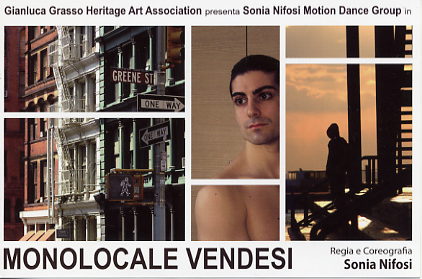
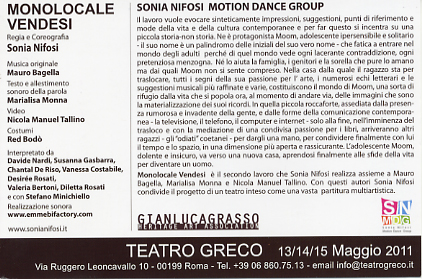
PHOTO GALLERY
GIULIETTA DEGLI SPIRITI
Questi ed altri fantasmi
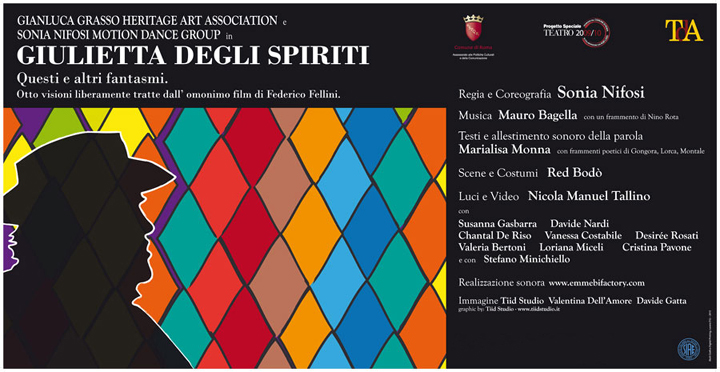
PHOTO GALLERY
|
L'ULTIMA DOMANDA
(The Last question)
(freely adapted from a story by Isaac Asimov)
for soprano, baritone, countertenor, diphonic singing,
reciting voice, electroacoustic processing and video
music: Mauro Bagella
libretto and direction: Marialisa Monna

Is it possible to massively reduce the amount of entropy in the universe? Or, will one day the human race, without wasting energy, be able to bring the sun to its full splendour even after it has died of old age?
Is this the last question asked by man to a powerful computer: Multivac, a name that echoes the Vedic vac, or "word", with reference to the element of the primordial universe. Billions of years passed and the question was asked several times to the computer that worked tirelessly to improve human life, to allow interstellar travel, defeat disease and lastly death. Over time Multivac perfected itself so well, able to keep the Universe in order and provide solutions to all of man's questions, but that last question remained: would they one day be able to turn on the stars?
Matter and energy will end, as will space and time. Even Multivac existed solely in the name of that last question. There was no more data to be collected. All that was left to do was correlate the data according to all possible connections. A timeless period was spent doing this until Multivac's mind worked out how to reverse the trend of entropy and finally answer that question. It embraced everything that had once been a Universe and pondered over what was now Chaos. Carefully it organized the programme and said, "Let there be light!" |
L'Ultima Domanda is part of a series of mini-operas, composed by Mauro Bagella, inspired by science fiction, with "surprising stories" collected in Amazing Stories, the first science fiction magazine published in the United States in 1926.

PHOTO GALLERY  photo by Massimo Alì Mohammad photo by Massimo Alì Mohammad
Napoli, Teatro Sancarluccio, Convivio Armonico IV ed., 01.04.2004
msopr. Rosa Montano; bs. Giusto Pio; cten and diph. sing. Mauro Bagella; act. Valerio Largo
|
|
| |
|
|
|
ARIONE
for countertenor, dancer
recorded voices, diphonic singing,
electroacoustic processing and video
music
Mauro Bagella
text and staging
Marialisa Monna
video
Donatella Vici
recorded voices
Serenella Isidori, mezzosoprano
Gino Nappo, baritone
direction
Marialisa Monna |
|
| |
| |
... A rare and sweet song ... set in a continuous motion of bodies ... in a performance space dressed in video... to tell the ancient story of the musician Arion sentenced to death by pirates and saved by a dolphin ...
Arione is a work for countertenor, dancer, two recorded voices, electroacoustic and video processing, lasting about sixty minutes.
The opera recounts the ancient story, told by Herodotus of Arion from Methymna, famous singer and citharist, and his miraculous rescue by a dolphin, the symbol of nature as provider and rescuer. The charm of the story - also revived as a metaphor of the tragicomic condition of the artist - above all in the vocal theme of the score, in its plot characterized by timeless storytelling, and a haunting, oneiric lament.
Arione is interpreted by the author as countertenor and with the intense souds of Diphonic singing. The two voices that converse with Arion are at times busybodies questioning him, or louts that want to loot and kill him, but not before hearing him sing for the last time, cynically ready to enjoy his art even at the extreme moment of such appalling cruelty.
As in other works by the same authors the gestural component, on the verge of dance is of structural importance. The character of Arion, in fact, finds in the dancer his double, his shadow, his secret soul.
The musical experimentation by Mauro Bagella, the visual art by Donatella Vici and ideation and direction by Marialisa Monna merge in search of a particular language for contemporary musical theatre. The stage is characterized by the interaction of video and props that contribute to creating a different and more complex visual horizon where the microkinetic paths of the countertenor and dancer meet.
I scene
Arione sleeps a restless sleep and in the middle of a nightmare wakes with a start. A group of busybodies want to know about the exciting adventure from which he had been recently saved. After shielding himself for a while, Arion finally tells his story: returning to Greece from a trip to Italy, where he exhibited his art as a musician and singer, at sea at night he was attacked by sailors who wanted to kill him and steal his prizes.
II scene
Like a flashback, the assault and torture of Arion on the ship is relived. Obsessive and cruel, the sailors tell Arion to choose whether to die by their hands or to kill himself. Desperate, Arion asked the louts, who cynically accept, to sing one last time and after a heartfelt farewell to life he throws himself into the sea.
III scene
Arion continues his story. Perhaps attracted by the song, "something" miraculous rescued him as he slid into the abyss. He can relive the moment a dolphin, the very expression of the deity of the sea, took him up to the fresh air of the night racing through the waves like a rhythmic dance, and brought him to shore. The heat of the earth beneath his feet is the heat of life itself which Arione clings to with unspeakable joy, with all his being, after he thought he had lost it. |
Interpreters
Alessandra Grasso graduated from the National Academy of Dance in 1982 and after having undertaken an exciting artistic journey as a dancer, dancing and working with important companies in major European opera houses, she has taken on a career as a choreographer and founded her own company bringing her works onto the stage.
She ended her personal triptych profession (dancer, choreographer, teacher), by creating in 1994 Il Centro Professionale di Balletto Espressione Danza, which this year celebrates 10 years of activity. The pupils of this school, who are always present in the major events of national ballet, have recently danced on the prestigious stage of the Kiev Opera and Ballet Theatre (Ukraine). Alessandra Grasso has performed some of her most significant choreographies for this prestigious company .
The meeting in the Sahara Desert with Claude Coldy's Danza Sensibile has helped her look towards movement that is an expression of the connection between herself and the world.
Serenella Isidori was born in Rome where she studied music and art. She graduated in Directing and Stage Design at the Centro Sperimentale di Cinematografia in Rome, studying with Charles Lizzani Valerio Zurlini Roberto Perpignani, Istvan Gaal, and Mario Garbuglia. She began to study singing in 1982, graduating in 1990 at the Conservatorio di Musica di Salerno. She studied with masters such as, Michiko Hirayama, Juliana Valente and Stefania Magnificent, and completed her studies with Claudine Ansermet for the execution of Baroque vocal music. She has given concerts as a soloist for various music associations both in Rome and other Italian cities and abroad. She is 'Professor of Performing Arts at the Conservatorio di Campobasso.
Gino Nappo, composer, harpsichordist and teacher, he studied at the Conservatorio di Santa Cecilia in Rome with Boris Porena and Paola Bernardi. He has given concerts as a pianist and harpsichordist, and in various chamber groups for important musical institutions in Italy and abroad, often collaborating with the Teatro dell'Opera in Rome. His work as translator and scholar in the last decade has focused on performance practices of the seventeenth and eighteenth centuries, with particular emphasis on vocal music and musical theatre. He has held seminars on bass and vocals in the seventeenth and eighteenth centuries. He has been Group Coordinator and Artistic Director of Musical Research and Experimentation (GRSM) for some years. He teaches score reading at the Conservatorio di Santa Cecilia in Rome.
PHOTO GALLERY  photo by Massimo Alì Mohammad photo by Massimo Alì Mohammad
Roma, Auditorium Goethe Institut, XXVII Stagione di Concerti di Musica Verticale, 13.12.04
msop. Serenella Isidori; bar. Gino Nappo; cten and diph. sing. Mauro Bagella
danz. Alessandra Grasso |
| |
|
| |
| |
L'INGORDIGIA PUNITA
or
La curiosa malattia di Messer Birillo Tappo
work for children by Mauro Bagella and Marialisa Monna
music by Mauro Bagella
stage adaptation by Laura Saraceni
for the Ballet Company of Mimma Testa
directed by Stefanella Testa
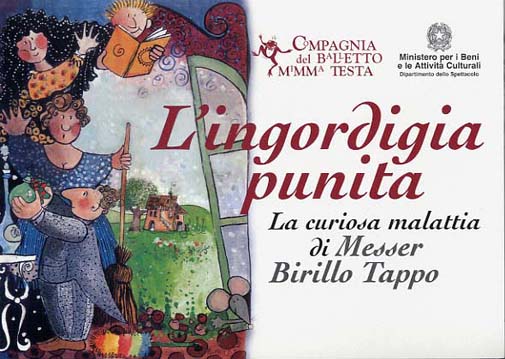
characters:
Messer Birillo Tappo
Madama Birillo Palla
Birillo Mamozio, the son
Madamigella Birillo, the daughter
Marone, il fattore
Annina, the farmer's wife
One Act with Prologue, three Scenes, two Intervals
Second half of the 1700's. Birillo Tappo, farmer's son owns a small printing shop.
With hard work he has managed to accumulate a considerable fortune consisting mainly of houses, lodges, country houses and farms. In the grip of a paroxysmal "demonic" mania for possession as he defines himself in a rare moment of lucidity, has purchased these from farmers who urbanize. On top of it all, his mania demands that he pay a visit to each of his innumerable houses, to be precise, that is three hundred and sixty-five days of the year. He is reluctantly accompanied in his wanderings, with a thousand groans, by his two sons, so that he, old and feeble, and does not withstand the hard work imposed on himself by his own insanity.
Shocked to witness such insanity is the wise farmer, Marone, who leads a life of hard rural work but surrounded by the diligent affection of his family.
Birillo Tappo boasts that he has not only a very large real estate,but also a title that comes from his wife, proud and indignant daughter of a fallen noble family. Thanks to this title, Birillo, though he hides it, married her without a dowry.
One "fine" day, however, a royal decree is to "disturb" the gasping wanderings of Birillo Tappo and his loved ones: "Whoever does not present their family noble title within three days, all property will be confiscated."
In a stormy and rousing scene, Palla confesses in tears that the pitiful lie lived for so many years has concealed the true origins of her family: she is not of noble birth but the daughter of a modest craftsmen. Overnight, Birillo Tappo loses all his villas and remains homeless.
At this point their child Mamozio, considered inept and constantly abused, reveals to his parents that he owns a cottage. It is the small but charming house which his farmer grandfather had left him in inheritance.
On a pleasant hill, his grandfather had lived his final years alone and forgotten, visited occasionally by his grandson. This revelation relieves Birillo and Palla from anxiety after the terror and humiliation experienced, they finally accept the fate of that one house, that kind destiny has reserved for them.
Birillo and Palla, crying, hugging their children and after asking their forgiveness, prepare themselves to lead a normal life.
Finally they will inhabit one house, finally they will abandon their aristocratic ambitions, satisfied with what they have. Everyone, including the wise farmer Marone and his family are preparing to celebrate the eventful coming to their senses. |
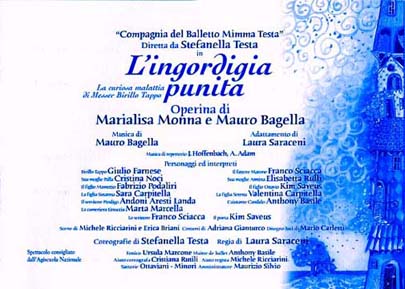
Illustrations of Gabila Rissone Musumeci
PHOTO GALLERY
Roma, Teatro Orione, 25.11.2003
Dance Company “Mimma Testa” |
| |
For further information on the performance of a music theatre piece, write to:
E-mail for information |
|








